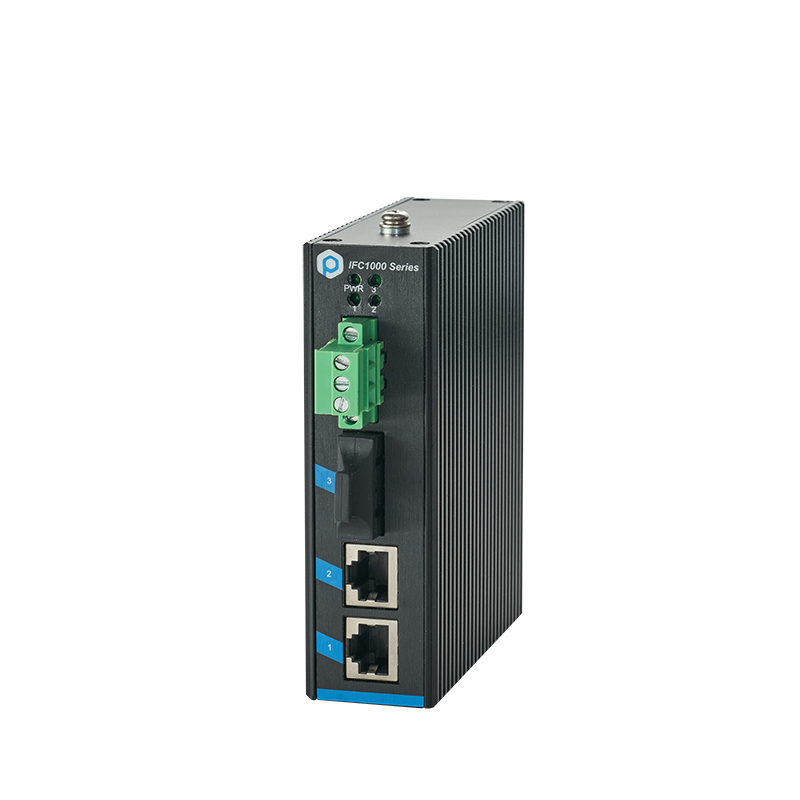Optical fiber switch and media converter (also called optical fiber transceiver) are important components of network data transmission equipment. What are the differences between them?
Optical fiber switch is a kind of high-speed network transmission relay equipment, also known as fibre channel switch and San (storage area network) switch. Compared with ordinary switches, it uses fiber optic cable as the transmission medium. The advantages of optical fiber transmission are high speed and strong anti-interference ability. There are mainly two types of optical switches. One is the FC switch used to connect storage. The other is an Ethernet switch. The port is an optical fiber interface. It has the same appearance as the common electrical interface, but the interface type is different.
Optical fiber switch is the smallest entity unit of communication network system. Generally speaking, it is composed of one or more communication switching interfaces, which includes switching mechanism, communication address manager, information transmission path selector, router, communication switching network controller and switching port. The switching mechanism can realize multi frame or multi circuit switching of communication signals; The switch port may be e port, f port or FL port. The multi-functional switch port is a switch that realizes more than one functional port.
Optical fiber switch is a high-performance management type two-layer optical fiber Ethernet access switch. The user can select the all-optical port configuration or the hybrid configuration of the optical port. The access optical fiber medium can be single-mode optical fiber or multi-mode optical fiber. The switch can support network remote management and local management at the same time to monitor the working status of the port and set the switch.

Media converter is a very economical, efficient and flexible device. Its common purpose is to convert electrical signals in twisted pair into optical signals. It is generally used in the actual network environment where Ethernet copper cable cannot cover and optical fiber must be used to extend the transmission distance. At the same time, it also plays a great role in helping to connect the last kilometer of optical fiber line to the metropolitan area network and the outer network.
Optical fiber switches differ from media converters:
1. The media converter provides data transmission with low delay and is completely transparent to the network protocol. ASIC chip is used to realize data line speed forwarding. Programmable ASIC integrates multiple functions into one chip, which has the advantages of simple design, high reliability, low power consumption, etc. it can make the equipment obtain higher performance and lower cost.
2. The Optical fiber switch is the connection between the fiber channel with high transmission rate and the server network, the fiber switch or the internal components of the San network. In this way, the entire storage network has a very wide bandwidth and provides a guarantee for high-performance data storage;
3. Optical fiber switch is a high-speed network transmission relay equipment. Compared with ordinary switches, it uses optical fiber cable as the transmission medium. The advantages of optical fiber transmission are high speed and strong resistance;
4. Media converter is a relatively simple network hardware device with fewer interfaces than switches, so its wiring and connection are relatively simple. They can be used alone or installed on the rack. As the optical fiber transceiver is a plug and play device, its installation steps are also very simple: the optical fiber switch can be point to multi-point, with more interfaces than the media converter. The installation is relatively complex. In the high-density cabling environment, the distribution frame, optical fiber box and cable management tools need to be used to manage cables and simplify wiring.
If the Ethernet network is too large, and the transmission distance has exceeded the transmission distance of electrical signals, photoelectric conversion is required at the electrical exchange port of the Ethernet switch. Therefore, Ethernet media converter is required to extend your transmission distance and convert electrical signals into optical signals for long-distance transmission.
In short, media converters are different from optical fiber switches. The use of transceivers is to send and receive information from one end of the transceiver. It is mainly used for the transmission of the main circuit, one at each end, so there is only one port generally. The optical fiber switch is used for data exchange between multiple ports, so it has multiple ports. Only their transmission media are different. One is ordinary 8-core network cable; One is realized through optical fiber and optical fiber module. Therefore, the media converter is one-to-one for long-distance transmission; The optical fiber switch is used for short-distance transmission and data transmission through multiple optical fiber modules.
Contact: sales
Phone: 18688787693
E-mail: sales@hsindustrialswitch.com
Add: Room 608, Building B,GaoXinQi TEC Park,Baoan District, ShenZhen,China